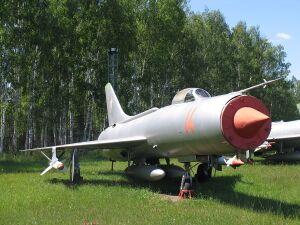Engineering:Sukhoi Su-11
| Su-11 | |
|---|---|

| |
| Role | Interceptor aircraft |
| National origin | Soviet Union |
| Manufacturer | Sukhoi |
| First flight | 25 December 1958 |
| Introduction | 1964 |
| Retired | 1983 |
| Primary user | Soviet Air Forces |
| Produced | 1962–1965 |
| Number built | 108 |
| Developed from | Sukhoi Su-9 |
| Variants | Sukhoi T-49 |
The Sukhoi Su-11 (NATO reporting name: Fishpot-C) was an interceptor aircraft used by the Soviet Union during the Cold War.
Design and development
The Su-11 was an upgraded version of the Sukhoi Su-9 ('Fishpot') interceptor, which had been developed in parallel with the OKB's swept wing Su-7 fighter bomber. Recognizing the Su-9's fundamental limitations, Sukhoi began work on the Su-11, which first flew in 1961 as the T-47 prototype.
The Su-11 shared the Su-9's delta wing, swept tailplanes and cigar-shaped fuselage, as well as the circular nose intake, but had a longer nose to accommodate the more powerful 'Oryol' (Eagle; NATO reporting name 'Skip Spin') radar set. A more powerful Lyulka AL-7F-1 turbojet was installed, providing 9.8 kN (2,210 lbf) more afterburning thrust for improved climb rate and high-altitude performance (and to compensate for increased weight). The Su-11 can be distinguished from the Su-9 by the external fuel pipes atop the fuselage, aft of the cockpit.
The Su-9's beam-riding K-5 missiles were replaced by a pair of R-98 (AA-3 'Anab') weapons, usually one R-98MR semi-active radar homing and one R-98MT infrared guided. Like many interceptors of the period, it had no cannon.
Production of the definitive Su-11-8M began in 1962, ended in 1965, after about 108 aircraft had been delivered, although it is believed that at least some Su-9s were upgraded to Su-11 form.
A conversion trainer version, the Su-11U 'Maiden,' was also developed ; Similar to the Su-9U, it had full armament and radar systems for training purposes, but the second seat reduced its already marginal fuel capacity and was not intended for combat use.
Operational history
Development problems and accidents delayed squadron introduction with the Soviet Air Force (VVS)/ Soviet Air Defence Forces (PVO) until 1964 and only small number of aircraft were delivered.
Even with the superior radar, the Su-11 remained heavily dependent on ground control interception (GCI) to vector its pilot onto targets. It had no capability against low-flying aircraft either, and Sukhoi OKB considered the Su-11 to be a misfire, much inferior to the far more formidable Su-15 ('Flagon'). Nevertheless, a few examples remained operational until the early 1980s. The last Su-11s left front-line service around 1983.
Operators
 Soviet Union
Soviet Union
- Soviet Air Defence Forces
Specifications (Su-11)
Data from OKB Sukhoi : a history of the design bureau and its aircraft[1]
General characteristics
- Crew: 1
- Length: 18.225 m (59 ft 10 in)
- Wingspan: 8.536 m (28 ft 0 in)
- Height: 4.7 m (15 ft 5 in)
- Wing area: 34 m2 (370 sq ft)
- Empty weight: 8,562 kg (18,876 lb)
- Gross weight: 12,674 kg (27,941 lb)
- Max takeoff weight: 13,986 kg (30,834 lb)
- Fuel capacity: 3,440 kg (7,580 lb) internal : 4,620 kg (10,190 lb) with external tanks
- Powerplant: 1 × Lyulka AL-7F-2 afterburning turbojet engine, 99.1 kN (22,270 lbf) thrust
Performance
- Maximum speed: 2,340 km/h (1,450 mph, 1,260 kn)
- Maximum speed: Mach 2.2
- Combat range: 500 km (310 mi, 270 nmi)
- Ferry range: 1,125 km (699 mi, 607 nmi)
- Endurance: 1 hour 28 minutes internal fuel; 1 hour 59 minutes with external fuel
- Service ceiling: 18,000 m (59,000 ft)
- Rate of climb: 136.7 m/s (26,910 ft/min)
- Wing loading: 76.09 kg/m2 (15.58 lb/sq ft)
- Thrust/weight: 0.71
- Take-off speed (internal fuel): 330–340 km/h (210–210 mph; 180–180 kn)
- Take-off speed (with external fuel): 360–380 km/h (220–240 mph; 190–210 kn)
- Landing speed (internal fuel): 280–290 km/h (170–180 mph; 150–160 kn)
- Landing roll: 1,000–1,200 m (3,300–3,900 ft)
Armament
- Missiles: 2 × K-8 air-to-air missiles
See also
Related development
Aircraft of comparable role, configuration and era
References
- ↑ Antonov, Vladimir; Gordon, Yefim; Gordyukov, Nikolai; Yakovlev, Vladimir; Zenkin, Vyacheslav; Carruth, Lenox; Miller, Jay (1996). OKB Sukhoi : a history of the design bureau and its aircraft (1st ed.). Earl Shilton: Midland Publishing. ISBN 9781857800128.
External links
 |

